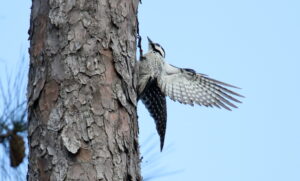Under the Endangered Species Act (ESA) it is illegal to destroy a member of an endangered species or to damage the species’ habitat. Yet the presence of an endangered species on a parcel of land may reduce or even eliminate the land’s value in uses other than species protection. In the thirty-plus years of the ESA’s existence, isolated reports have suggested that owners might be seeking to protect the value of their properties by reducing their suitability as habitat– possibly before any endangered species arrive. Recent research appears to validate these reports.
Dean Lueck and Jeffrey Michael (2003) show that owners of timberland close to land with colonies of protected red-cockaded woodpeckers (RCW) are more likely to harvest their timber when it is less mature. Because RCWs rely on mature timber stands for nesting, these actions reduce habitat for the birds and, perhaps, further threaten their existence.
The red-cockaded woodpecker is a nonmigratory, territorial woodpecker that resides primarily in southern pine ecosystems ranging from Texas to Florida to Virginia. It has had endangered status since 1970, with only about 4,700 nesting pairs believed to exist today. About 20 percent of these birds inhabit private lands, most notably in North Carolina, the area studied by Lueck and Michael. When RCWs leave their birth colony they may travel up to 15 miles to excavate a nest in a suitable pine, one preferably 70 years old, but at least 40 years old. During the period of this study (the late 1980s), the owner of any timberland on which RCWs were nesting was not allowed to harvest timber within a 60- to 300-acre area around the nest. This government-mandated restriction could cost a landowner up to $200,000 in lost timber profits.
Because RCWs are willing to travel up to 15 miles to found a new colony, landowners within such a radius of existing colonies face a substantial risk of economic loss due to RCW colonization. One might expect them to take steps to reduce or eliminate the chance of such loss, and this is exactly what Lueck and Michael are able to establish. Because of the woodpeckers’ insistence on mature pines for their nests, the simplest way to protect against colonization is to log trees before they reach the age preferred by the RCW–and this is what many landowners appear to have done.
Of course, many things affect the harvest decision, including the value of the standing timber, the productivity of the land, and the species of pines involved. After controlling for all these factors, Lueck and Michael find that for properties located within 15 miles of existing RCW colonies, harvesting decisions are systematically influenced in two ways. First, landowners are more likely to harvest; indeed, land within 15 miles of a property that is relatively heavily populated with RCWs is about 15 percent more likely to be harvested. Second, landowners threatened by woodpecker colonization tend to harvest trees when they are younger. Overall, proximity to high-density RCW colonies cuts harvest age by about three years. Although landowners are no doubt changing behavior in a variety of ways, this finding is consistent with about 10 percent of landowners reducing their rotation periods from 70 years to 40 years.
Looking only at the timber side of things, the damage done by the ESA in inducing earlier logging is probably small: When stands are managed solely for commercial timber harvest, they tend to be harvested before the age of 40 (and thus before they are attractive to RCWs). The damage really comes on stands managed for conservation uses, such as for environmental amenities and hunting, in addition to timber. These are the properties most likely to be harvested, and harvested sooner due to the ESA, resulting in the loss of these amenities.
The other damage comes to the woodpecker itself. The ESA surely has protected some colonies by preventing habitat destruction where colonies were already located. But some of this beneficial effect has been eliminated because the ESA promotes habitat destruction on property close to RCW-colonized lands. The authors estimate that up 80 percent of the apparent benefits of the ESA were wiped out by the perverse incentives it created: Even while saving up to 84 colonies on one set of properties, it may have prevented the formation of up to 67 colonies on other lands.
Following the period covered by this study, the Fish and Wildlife Service chose to ease ESA rules as they applied to lands inhabitable by RCWs. These regulatory changes reduced the costs to landowners of colonization, and thus presumably reduced the incentive to harvest timberlands prematurely. But the evidence developed by Lueck and Michael makes two points abundantly clear. First, because of the perverse incentives created by the ESA, this law has accomplished less than many people think. Second, people respond to incentives; only by giving them appropriate incentives will we maximize the environmental protection achievable with a given expenditure of resources. Incentives matter, not just to people, but to woodpeckers, too.
REFERENCE
Lueck, Dean, and Jeffrey A. Michael. 2003. Preemptive Habitat Destruction under the Endangered Species Act. Journal of Law & Economics 46(1): 27-60.
Daniel K. Benjamin is a PERC senior associate and professor of economics at Clemson University. His regular column, “Tangents-Where Research and Policy Meet,” investigates policy implications of recent academic research. He can be reached at: wahoo@clemson.edu




